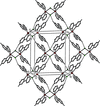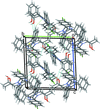issue contents
January 2017 issue

Cover illustration: [Cu(ClO4)(cyclen)]ClO4[Cu(ClO4)(cyclen)]ClO4 (cyclen = 1,4,7,10-tetraazacyclododecane, C8H20N4), prepared without solvent molecules of crystallization, exhibits a square-pyramidal CuN4O coordination geometry for the metal ion, with a perchlorate-O atom occupying the apical site. An N-H O hydrogen bond from one of the cyclen NH groups reinforces the linkage between the Cu2+ ion and the anion. See: Gray, Gerlach & Papish [Acta Cryst. (2017). E73, 31-34].
O hydrogen bond from one of the cyclen NH groups reinforces the linkage between the Cu2+ ion and the anion. See: Gray, Gerlach & Papish [Acta Cryst. (2017). E73, 31-34].
research communications
Download citation


Download citation


The title crystal is a co-crystal with the 1,8-naphthyridine derivative crystallizing with one molecule of succinimide per formula unit. In the crystal, the two molecules are mutually linked by N—H⋯O and N—H⋯N hydrogen bonds. The packing is consolidated by C—H⋯(O,N) hydrogen bonds and π–π stacking interactions.
CCDC reference: 1519551
Download citation


Download citation


The title compound crystallizes with two independent centrosymmetric dimers in the unit cell, each featuring a typical pincer-type structure where the dianionic ligand is tetradentate, coordinating to the central tin atom through both phenolate oxygen atoms, as well as through the quinoline and imine N atoms. Each metal atom adopts a distorted pentagonal–bipyramidal SnC2N2O3 coordination arising from the N,N′,O,O′-tetradentate deprotonated Schiff base and two butyl groups in the axial sites.
CCDC reference: 1519148
Download citation


Download citation


The first example of an NiII complex containing an σ-dimerized TCNQ–TCNQ unit is presented, with a C—C bond length of 1.653 (11) Å. In addition, the σ-dimerized TCNQ–TCNQ unit (refined 75% occupancy) is disordered, forming also a less populated pair of TCNQ molecules (25% occupancy) with tightly π-stacked dicyanomethanide groups.
CCDC reference: 1520298
Download citation


Download citation


The conformation of the title compound is cone-shaped, partially determined by short intramolecular C—H⋯O contacts. In the crystal, molecules are linked via C—H⋯O and C—H⋯F hydrogen bonds and C—H⋯π interactions, forming a three-dimensional supramolecular structure.
CCDC reference: 1519443
Download citation


Download citation


The ZnII ion in the title compound shows a distorted square-pyramidal coordination geometry with three N atoms of the chiral S-ppme ligand and two N atoms of the thiocyanate anions. In the crystal, molecules are connected by hydrogen bonds and π–π interactions, forming a two-dimensional supramolecular network parallel to the bc plane.
CCDC reference: 1520395
Download citation


Download citation


In the title compounds, the thiosemicarbazone group adopts an extended conformation, and there is a short N—H⋯N contact present forming an S(5) ring motif. In the crystals of both compounds, molecules are linked by pairs of N—H⋯S hydrogen bonds, forming dimers with  (8) ring motifs.
(8) ring motifs.
Download citation


Download citation


In the crystal, the coordination dimers are linked via N—H⋯O, N—H⋯N and C—H⋯O hydrogen bonds and π–π stacking interactions into a two-dimensional framework parallel to (100).
CCDC reference: 1520114
Download citation


Download citation


In the title structure, the CdII atom is located on a twofold rotation axis and is coordinated by two I atoms and two N atoms of two carboxylate groups of two planar N′-[(E)-4-hydroxybenzylidene]pyridine-4-carbohydrazide ligands. N—H⋯O, O—H⋯O, C—H⋯O and C—H⋯I hydrogen bonding assembles the molecules into a three-dimensional network.
CCDC reference: 1521096
Download citation


Download citation


The crystal structure of (perchlorato-κO)(1,4,7,10-tetraazacyclododecane-κ4N)copper(II) perchlorate is reported. The crystal was grown from a solution of methanol at ambient temperature which resulted in no co-crystallization of solvent.
CCDC reference: 1521075
Download citation


Download citation


The title compound, N-(4-chlorophenyl)-5,7-dimethyl-1,2,4-triazolo[1,5-a]pyrimidin-2-amine, was synthesized by cyclization of 1-(4,6-dimethylpyrimidin-2-yl)-4-phenylthiosemicarbazide in the presence of Ni(NO3)2. In the crystal, molecules form inversion dimers via pairs of N—H⋯N hydrogen bonds, which are packed into layers by π-stacking interactions between the aromatic systems of neighbouring molecules.
CCDC reference: 1521445
Download citation


Download citation


In the title compound, the hydroxy group forms a intramolecular hydrogen bond to the imine N atom and generates an S(6) ring motif. The conformation about the C=N bond is E, and the aromatic ring of the julolidine moiety is inclined to the benzene ring by 3.74 (14)°.
CCDC reference: 1521905
Download citation


Download citation


The mononuclear title complex contains a chloride, a 1-(4-nitrophenyl)thiourea and two triphenylphosphane ligands, leading to a tetrahedrally arranged ClP2S coordination set. N—H⋯Cl and C—H⋯O hydrogen bonds connect the molecules into a three-dimensional network.
CCDC reference: 1520741
Download citation


Download citation


In the title compound, C16H9ClO4, the dihedral angle between the coumarin ring system [maximum deviation = 0.023 (1) Å] and the benzene ring is 73.95 (8)°.
CCDC reference: 1521043
Download citation


Download citation


In the title compound, which was prepared using a hydrothermal reaction between 2,2′-bipyridine, cadmium(II) chloride and potassium 1,1,3,3-tetracyano-2-ethoxypropenide, the complex cations are linked into sheets by C—H⋯Cl hydrogen bonds.
CCDC reference: 1521824
Download citation


Download citation


In the title compound, the CuI atom is coordinated by two S atoms and two I atoms in a distorted tetrahedral mode.
CCDC reference: 1522053
Download citation


Download citation


In the title compound, the dihedral angle between the mean planes of the coumarin and β-carboline ring systems is 63.8 (2)°. In the crystal, molecules are linked via N—H⋯N hydrogen bonds, forming chains along the [010] direction.
CCDC reference: 1522101
Download citation


Download citation


The molecular and crystal structure of the title imidazole derivative is reported. The structure is stabilized by an extensive O—H⋯N, C—H⋯O/Cl and C—H⋯π(ring) hydrogen-bonding network.
CCDC reference: 1520559
Download citation


Download citation


In the crystal structures of title compounds, two identical protonated dextromethorphan cations are connected to tetrachloridocobaltate (or tetrachloridocuprate) anions via strong N—H⋯Cl hydrogen bonds, forming neutral ion associates
Download citation


Download citation


The title binuclear μ-pyridylvinylidene FePd complex (FePd1) was obtained from Cp(CO)2FeI and 2-ethynylpyridine in diisorpopylamine in the presence of PdCl2
CCDC reference: 1523136
Download citation


Download citation


The asymmetric unit of the title compound comprises of one complex cation, one half of a Cr2O72− anion and one half of a water molecule. The CrIII ion has a distorted octahedral coordination by four N atoms of the cyclam ligand and by two N-bonded NCS groups in cis positions; the conformation of the dichromate anion is staggered.
CCDC reference: 1523266
Download citation


Download citation


The solid-state structure of the title salt, [H3N(CH2)6NH3][(HO)O2P(CH2)6PO2(OH)], possesses a herringbone motif as a consequence of the interplay of strong hydrogen bonds and non-covalent interactions.
CCDC reference: 1522538
Download citation


Download citation


The crystal structure of a homocoupled compound with absolute configuration 3aR,3′aR,7aS,7′aS was determined. The molecule contains two similar moieties composed of two fused rings. Its supramolecular structure is controlled mainly by C—H⋯O interactions.
CCDC reference: 1522804
Download citation


Download citation


A new isoxazolidine has been obtained by 1,3-dipolar cycloaddition of a nitrone and phenyl vinyl sulfone
CCDC reference: 1519195
Download citation


Download citation


The synthesis and structure of a rare example of a trigonal–bipyramidal titanium coordination complex with three chlorides and two oxygen donor ligands is reported.
CCDC reference: 1523643
Download citation


Download citation


The crystal structure of dirubidium hydrogen citrate has been solved and refined using laboratory X-ray powder diffraction data, and optimized using density functional techniques.


 journal menu
journal menu











































